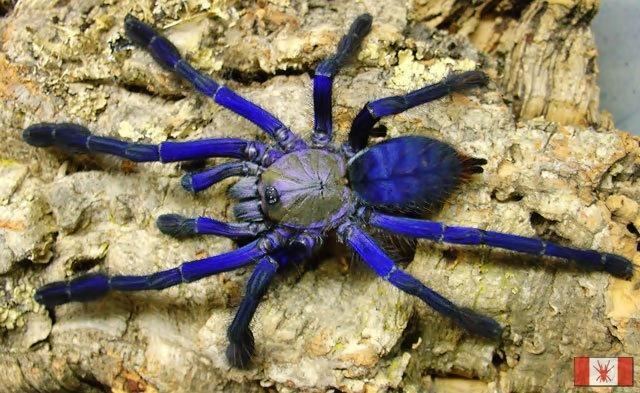Scientific name Lampropelma violaceopes Rank Species | Order Araneae Family Theraphosidae Higher classification Lampropelma | |
 | ||
Similar Lampropelma, Cyriopagopus, Cobalt blue tarantula, Venezuelan suntiger, Greenbottle blue tarantula | ||
Singapore blue rehouse what fun lol
The Singapore blue (Lampropelma violaceopes) is a large, arboreal species of tarantula from Malaysia and Singapore. These spiders have been known to grow in excess of 9 inches (23 cm) across. The legs are an intense blue with a brown or gold carapace. The male is usually not as vibrant, the species exhibiting sexual dimorphism. The generic placement of the species has been questioned, and specimens identified as males of this species may actually be from a different species.
Contents
- Singapore blue rehouse what fun lol
- Singapore blue tarantula wondering around
- Taxonomy
- Food
- In captivity
- References

Singapore blue tarantula wondering around
Taxonomy

Lampropelma violaceopes was first described by H. C. Abraham in 1924, under the name Lampropelma violaceopedes. However, specific names under the International Code of Zoological Nomenclature cannot be plural, so violaceopedes was corrected to violaceopes.

Relationships among a number of genera of East Asian spiders are unclear as of July 2016. A. M. Smith and M. A. Jacobi in 2015 said that female specimens of Lampropelma violaceopes should be placed in the genus Omothymus, whereas male specimens are misidentified members of a different species, Cyriopagopus schioedtei. However, the name Lampropelma violaceopes for the female is accepted by the World Spider Catalog as of July 2016, with the comment that the transfer to Omothymus is "not sufficiently justified".
Food
Diet consists primarily of beetles, cockroaches, crickets, young mice, birds and other small animals. During feeding, the abdomen (opisthosoma) will often increase its size two-fold.
In captivity
Singapore blues are common as pets because of their beautiful colours. Caution should be taken as these are very defensive animals. They will defend themselves using their venom transferred via fangs.
Recommended feeding includes four to six live crickets every few weeks. Gut loading, or providing prey with vitamins and other nutrients, provides tarantulas with a healthy meal. Uneaten prey should be removed after one day. Fasting, or not eating, for days or weeks at a time is sometimes an indication of an upcoming moult. A water dish should be supplied and maintained, shallow enough for the tarantula to drink from.
